What no one wants you to know about marketing attribution: 7 models and their pros & cons

Half the money I spend on advertising is wasted; the trouble is I don’t know which half.
John Wanamaker (1874)
As marketers, it’s infuriating to spend our limited budgets with no understanding of how it’s affecting our bottom line. As business owners, it’s downright scary.
Wanamaker’s complaint suggests the problem of marketing attribution is even older than Coca-Cola. After reading this guide, you’ll know more about marketing reporting attribution than most of the marketing world.
What is marketing attribution?
Attribution is the action of regarding something as being caused by a person or thing.
In marketing, attribution is commonly understood as the science of how you assign credit for revenue across various customer touch points.
Marketing attribution matters because it helps identify which channel or activity is the most impactful in terms of generating revenue for your business. Understanding this helps inform how you allocate your time, energy, and hard-earned cash to increase the likelihood that you grow as efficiently as possible.
Your largest costs will generally be marketing, and so you want to make sure you are spending those dollars efficiently and wisely.
Moiz Ali, founder, Native
“Your largest costs will generally be marketing, and so you want to make sure you are spending those dollars efficiently and wisely,” says Moiz Ali, founder of Native.
The first thing to know about attribution theory is that there are many ways to look at the problem, resulting in different attribution models.
This is because buyer journeys aren’t really linear.
We don’t see an ad, think it’s cool, go to a website, sign up for the newsletter, get an email, then buy.
Instead, we see billboards, talk to friends, engage on social, see Facebook ads, browse by Google ads, get emails and texts, visit websites, hear more ads, talk to more friends, swipe up…and we never do any of these in the same order, at the same time, or in the same way.
You would think marketing attribution is simpler in the digital age and with so many advancements in MarTech, but it’s more complicated than ever.
Chantelle Marcelle, marketing consultant
“You would think marketing attribution is simpler in the digital age and with so many advancements in MarTech, but it’s more complicated than ever,” says Chantelle Marcelle, a marketing consultant. “The customer journey doesn’t follow a linear path that can be tracked without getting intentional, disciplined and consistent with data management.”
With consumers taking so many different paths to purchase, how do we, as marketers, get our arms around which of our activities lead to sales and which don’t?
Simplicity versus precision: pick your poison
There are various attribution models that each serve a different purpose, and we’ll cover all below.
To choose which you go with, think about your goals and pick the model that best suits your needs. Then, stick with it.
“Don’t get stuck picking the perfect model,” says BJ Cook, president of 85Sixty. “Ask what you need from attribution and make sure your team is comfortable with the logic.”
Don’t get stuck picking the perfect model.
BJ Cook, president, 85Sixty
These different models differ in how precise vs. how simple they are.

The good news is that simple models are generally precise enough for most marketers. Marketers with budgets over $100M may need a more fine grained understanding of marketing spend efficiency across various channels.
Below is a good way to see where you fall on the precision versus simplicity scale based on your revenue.

The 7 common marketing attribution models
There are 7 main types of marketing attribution models, and each differ based on their simplicity versus precision. We’ll explore each of these, from the most simple to the most precise, so you can choose the model that supports your internal attribution goals.
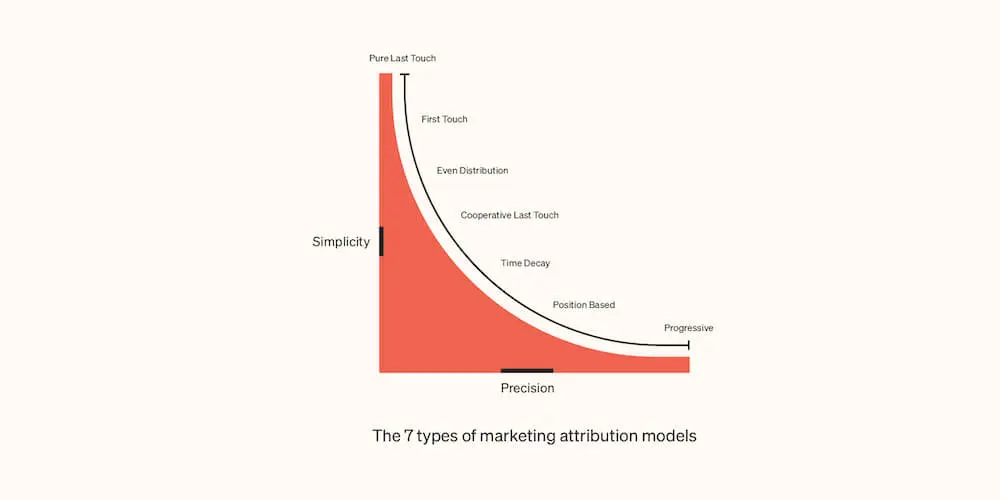
In order to explore these marketing attribution models on an even plane, let’s use an example of a relatively common buyer journey:

In this journey, we can see that the consumer interacted with several different channels across different platforms like TikTok, Facebook ads, and SEO. Some of those channels were paid, and others were not. Some were owned channels, and others were third-party.
All of it, though, eventually led to a purchase.
Here’s the thing: every consumer’s journey to buying your product will be slightly different. There is no exact template. But, marketing and sales teams do try to understand which of these actions within the journey have the most value.
The central question marketing attribution aims to answer: Which of these activities contributed to the sale and which did not?
It is, of course, the central question marketing attribution aims to answer: Which of these activities contributed to the sale and which did not?
Pure last touch attribution
Pure last touch attribution models give 100% of the credit to the last interaction a consumer had before coming to the website and purchasing.
This model is very simple to implement and understand. It’s fantastic for brands who are just starting out or those which use few channels to reach their customers.
It’s also a really helpful model to use to evaluate specific messages or ads within a single channel, and to compare which specific interaction is the most effective in driving revenue.
In our example, email would get 100% of the credit.
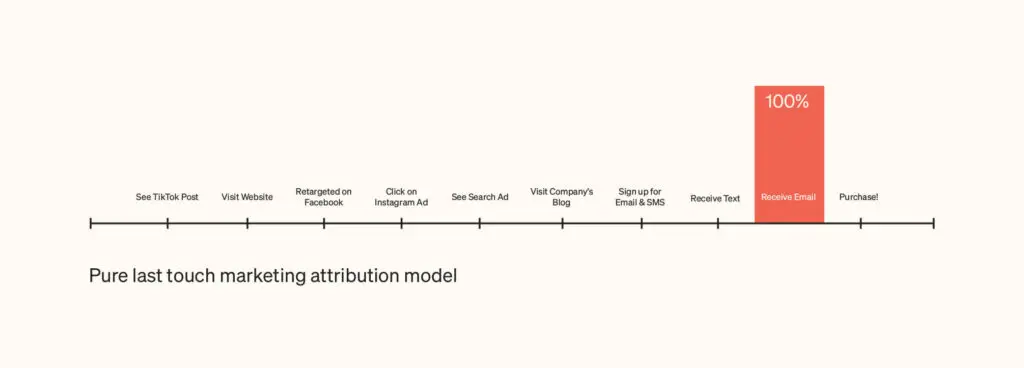
Pure last touch attribution starts to fall short when brands use multiple channels and want to compare how they might be influencing each other.
First touch attribution
The first touch attribution model gives 100% of the credit to the first interaction a consumer had before eventually purchasing.
This is a useful model when you’re interested in understanding which original sources or channels are the best at starting a buyer’s journey with your brand.
In our example, TikTok would get 100% of the credit for the purchase.

The benefit of first touch attribution is that it’s super simple to understand and relatively simple to find tools that will provide this view.
The downside is that setting up the technology to appropriately identify a visitor from their first touchpoint to their last can be quite technical and tricky, especially as they interact with your brand on different platforms.
Additionally, first touch attribution makes it tough to appreciate the nuance of intention behind the purchase. You might pique someone’s interest with a funny TikTok reel, but convert them with an email about a deep discount.
Even distribution attribution
The even distribution model is a great approach when you want to understand how a mix of touchpoints contributes to a purchase.
In our example, every touchpoint that we’re able to measure would get equal credit.

The benefit of even distribution is that you can weigh each step of the user journey evenly and look at which steps show up the most often in paths that eventually convert.
The challenge is that most attribution efforts are aimed at understanding which steps are most valuable so you can double down on what is working and cut what isn’t working.
This model could over attribute steps that you paid for or that have particularly wide distribution, even if they aren’t that influential.
That means that this model could over attribute steps that you paid for or that have particularly wide distribution, even if they aren’t that influential.
Additionally, managing a platform that can accurately keep track of each step takes a good amount of time to configure.
The cooperative last touch attribution model
The cooperative last touch model is an evolution of last touch attribution that takes two different channels into account. These two channels are often used synchronistically by the marketer and are generated from the same marketing technology tool.
This is a useful model when two different channels have different attribution windows and a marketer wants to make sure that the activity that actually inspired the purchase is the one that gets the credit, regardless of which happened first.
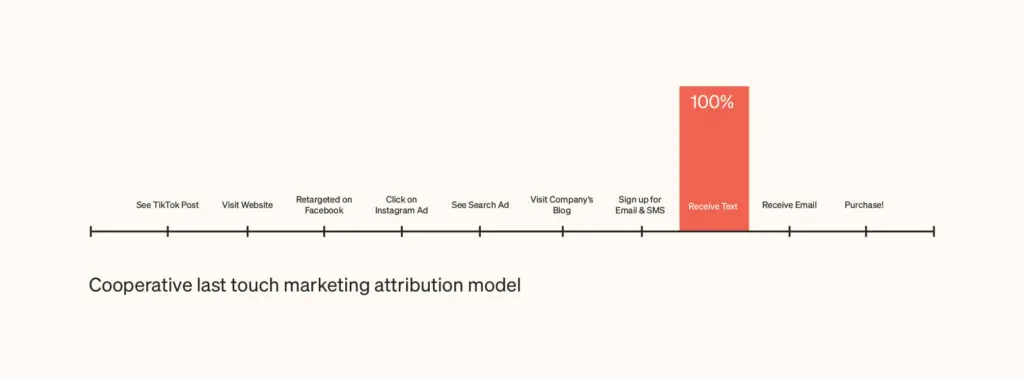
The benefit of cooperative last touch is that it prioritizes a consumer’s action over a marketer’s action. This is because it takes attribution windows by channel into account. Then, cooperative last touch assigns attribution to the last channel that drove the revenue as long as the purchase happened within the attribution window.
The benefit of cooperative last touch is that it prioritizes a consumer’s action over a marketer’s action.
This provides a simple way for marketers to balance multiple channels.
The challenge with cooperative last touch is that it is relatively new and requires a platform to build the technology to support it.
Additionally, you may want to customize attribution windows based on your sales cycle. For example, luxury furniture companies may want a longer attribution window than those that sell supplements or socks. Be sure to use a platform that gives you this flexibility.
Learn more about Klaviyo’s cooperative last touch attribution model: Klaviyo recently updated its attribution model to better support multi-touch customer journeys across your SMS and email campaigns and automations.
Time decay attribution
The time decay attribution model is an evolution from the even distribution model that seeks to give more credit to interactions that happen closer to the conversion.
In our example, each step would get a different weighting of attribution. Typically, the total conversion amount (e.g. $75) would get split up and a different amount of revenue would be allocated to each step. So, “click on instagram ad” would get $3.75 of attribution, in our example.
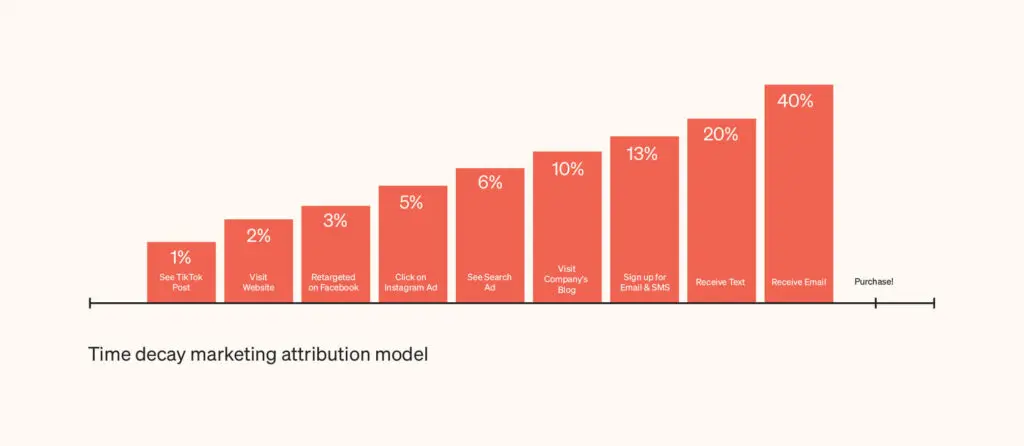
The benefit of this model is that it takes all steps in the journey into account, and gives different weights to each step based on when they occured. This means you can appropriately weigh the events that likely influenced the conversion, without over-attributing the events that may have started the relationship.
The challenge to this model is––well––it’s complicated. How do you know these are the right weights, for instance?
Some very sophisticated marketers take a time decay model and then customize it to weight each step differently. Unless a brand has many different touchpoints in market, a large advertising budget, and the scale needed so that a 1-5% performance improvement is incredibly impactful to the bottom line, this model is probably overkill.
Additionally, the weighting by step can and should vary depending on how much time elapsed between each step. Google Analytics provides this view and manages it for you.
That said, when evaluating performance, it can be tricky to explain if one step had a material change in performance, as each interaction is weighted differently based on position and time from the conversion event.
Position-based attribution
Also known as U-shaped attribution, the position based attribution model gives 40% to the first touchpoint and 40% to the last touchpoint, then divides the remaining 20% of attribution among the touchpoints in between.

This multi-touch attribution approach is an improvement from even distribution in that it overweights the first and last touchpoints, which are typically the moments of most importance to marketers.
That said, this model can often underweight some of the most important touchpoints in the middle of the journey. In our example, for instance, an expensive retargeting ad and a free, search driven first visit to the company’s blog would be weighted the same.
Progressive attribution
The progressive attribution model is a very complex and precise way of measuring a series of progressive conversions that, when stitched together, create a holistic buyer journey.
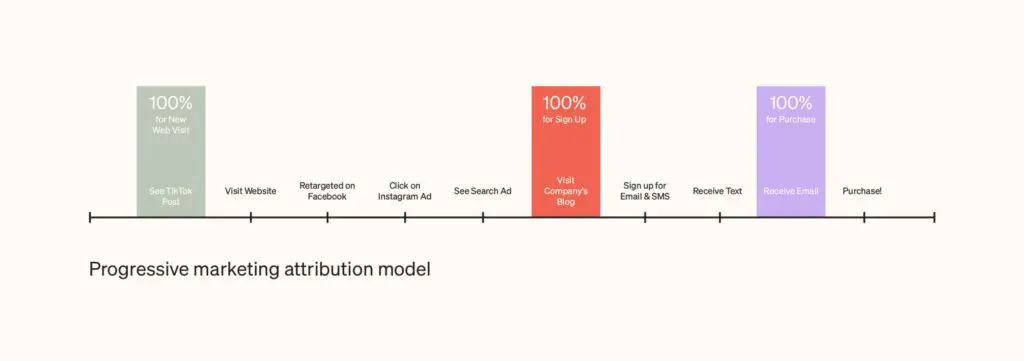
This approach is most helpful when you have a large marketing department with various teams working on multiple experiences to advance large groups of people closer to purchase.
Setting it up can be challenging. You need to:
- Agree on which conversion events.
- Determine how to define those events.
- Assign ownership of setting those up.
- Connect those events back to your analytics platform or tracking infrastructure.
- Decide on a reporting cadence to the larger team.
- Then demonstrate in those reports how one conversion leads to another.
Your attribution measurement options
There are a variety of different ways to measure attribution based on the model you choose and the software you use. Many companies, including Klaviyo, offer attribution models within their platforms to help marketers understand the ROI of their efforts from that platform.
But be careful here. Not all platforms measure the same, and all of them are incentivized to show their impact on your revenue.
Klaviyo’s conservative approach to attribution: Klaviyo offers channel specific, customizable attribution windows. By default, the email attribution window is 5 days and the SMS attribution window is 24 hours. You can be confident there is little to no “double counting” happening in Klaviyo.
Ad network measurement
Platforms like Google, Facebook, TikTok, and Snapchat all invest tremendous energy to make it easy for advertisers to understand how much revenue was attributed to advertisements spent on each platform.
Why? Because if they can prove that spending on their platforms generates more money for brands, then you will spend more with them.
Ad network attribution pros & cons
When weighing whether or not to use the attribution reporting from a given ad network, consider the attribution windows and method of attribution.
Some platforms use very generous attribution windows that cannot be customized to your needs. For example, Facebook used to have a 28 day attribution window, until they shortened it to 7 days.
After the attribution window adjustment, many brands discovered they had been over-investing in Facebook and Instagram ads. When the attribution window was properly reduced, brands shifted budget and Facebook saw a $10B reduction in ad spend on their platform.
In addition, properly attributing an action taken on a platform like Facebook back to a conversion action on your website requires one of two things to occur:
- The use of cookies to identify a specific browser and track when they go from point A (Facebook) to point B (your site)
- The use of a single technology or tool that is able to view the entire journey (i.e. through web browsers like Chrome or Safari) and can then give you reporting on what people are doing across various sites and platforms
New privacy regulations and consumer sentiment have made cross-domain tracking more of a gray legal area, and it is becoming increasingly difficult to implement it at all.
New privacy regulations and consumer sentiment have made cross-domain tracking more of a gray legal area, and it is becoming increasingly difficult to implement it at all.
In their iOS14.5 update, Apple made it possible for consumers to opt out of being tracked within apps, like Facebook or Instagram, so advertisers cannot identify users who come from those platforms. This means it isn’t possible to identify that visitor or subsequently attribute a purchase to a previous advertisement or social media engagement.
Because of the inability to track across domains, some advertising platforms now need to ingest data from various tools and reconcile user behavior after the fact. In Facebook’s case, this can take hours or days given the amount of data they are processing.
As a result, it is very difficult for advertisers to get the real-time reporting they need to balance their ad budgets and optimize spend in third-party channels.
Marketing solution providers
Tools like Klaviyo, Mailchimp, Postscript, Attentive or other CRM-like solutions help you market to your audience directly and seek to demonstrate your ROI so you continue to use their platform.
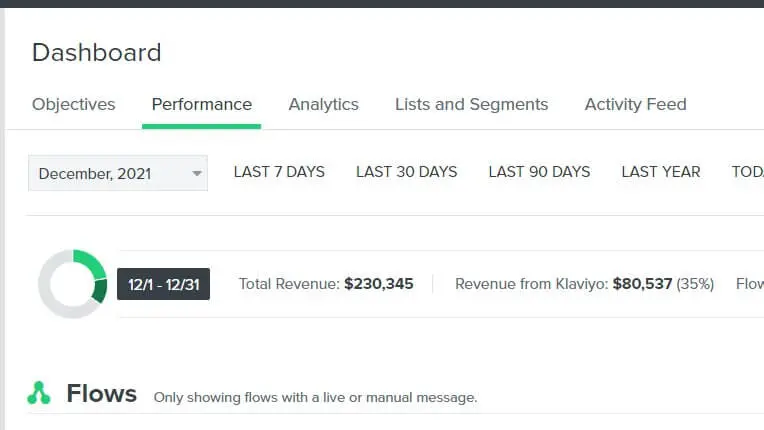
Marketing Solution Provider attribution pros and cons
Within your marketing tech stack, you’ll have two different software options:
- Point solution providers: These are tools and technology within your stack that only solve for one need, across a single distribution channel. Some brands use a point solution for email only, or for SMS only, for instance.
- Multi-channel solution provider: These are tools and technology within your stack that you can use for a variety of different marketing activities across multiple distribution channels. For instance, Klaviyo is a multi-channel solution provider through which you can send both email and SMS messages.
How point solution providers measure attribution
Point solution providers are incentivized to help you understand how their tool impacts your revenue, but they are not incentivized to help you understand how a variety of marketing activities impact your bottom line.
In these cases, you may see over-attributed revenue to the channel the point solution provider offers. This makes things really confusing for folks when they decide to upgrade to multi-channel tools, instead.
Point solution providers don’t track external attributions or multiple marketing channels, and as a result, the attribution models within these platforms tend to orient toward simpler attribution strategies. They tend to rely on pure last touch.
Single channel tools tend to be clear in their presentation, but the data just isn’t there to accurately paint a clear picture.
Nick Parente, owner, The Custom Captain
“Single channel tools tend to be clear in their presentation, but the data just isn’t there to accurately paint a clear picture,” says Nick Parente, Owner of The Custom Captain.
Another thing to look out for here is the point solution provider’s attribution window. Because these providers want to showcase high ROI for the use of their tool, they often use long attribution windows similar to what Facebook used before privacy updates forced them to recalibrate in 2021.
For email point solution providers, Apple’s privacy updates in 2021 made it more difficult to provide an understanding of attribution. Consumers can now hide their email address from senders, making it harder for marketing platforms to track emails by obfuscating a recipients IP address and whether or not they opened an email.
Be sure to understand how a given platform handles reporting for Apple email users.
How multi-channel solution providers measure attribution
There are four flavors of challenges you can run in to with multi-channel providers:
- Configuring attribution logic
- Managing integrations and data feeds
- Rigidity around specific attribution windows
- Handling Apple’s Mail Privacy Protection
The configuring attribution logic pitfall
In order to attribute a purchase to a specific marketing activity, you must know when both the marketing activity and the purchase occurred.
For a multi-channel provider, the challenge is in knowing when that purchase occurred.
In general, there are two ways platforms address this:
- Download all transactions from the ecommerce store,
- Integrate with the ecommerce store to tell the marketing platform when an attributable transaction has occurred.
The preferred method is to download all transactions and then reconcile. The challenge is that it can be difficult to build this.
If a platform doesn’t download all of the transactions, then it may require the store to include certain UTM parameters in every single URL sent in any email.tThis is a signal that is used by the marketing platform’s tracking script on your website to recognize if a transaction came from a session that was driven by a marketing activity.
Managing integrations and data feeds
There are 3 ways integrations between multi-channel marketing platforms and ecommerce platforms can work:
- The marketing platform builds it
- A third party builds it
- The store builds it
If you choose a marketing platform that builds the integration, be sure that it integrates all the data you need and syncs the data frequently, so you get quality, real-time reporting.
In many cases, you either need to write your own integration or supplement the existing one to get the data you need at the speed you need it. Be sure to understand the requirements before you choose a platform so you can ensure you have the resources to support your needs.
Rigidity around channel specific attribution windows
Make sure you understand the logic a platform uses to determine attribution.
Some platforms want to build the simplest attribution model possible, so they attribute whatever you tell them to.This is the case when they require you to add UTM parameters to URLs so that the platform can identify if a click led to a transaction.
Other platforms take as much attribution credit as possible. They do this by making attribution windows back to their tool incredibly long––like 28 days long, for instance.

Source: Chormaic on Twitter
Many of these same platforms don’t let brands edit that attribution window, or require you to talk to a support representative to request a change in writing.
“Most often the attribution window is too large and unadjustable. One vendor, for example, uses a 7-day window for SMS, which in my opinion is way too long for this channel,” says Kasey Luck, Owner of Luck & Co.
“I forget about open SMS messages on my phone within 3 hours. Oh, and also the most common thing is, you can’t find what attribution model they use in their docs online. You have to reach out to support and ask about it.”
One vendor, for example, uses a 7-day window for SMS, which in my opinion is way too long for this channel.
Kasey Luck, owner, Luck & Co.
Other platforms still, like Klaviyo, invest extra energy to make it easy for you to configure attribution windows however you want, whenever you want.
This is simply what is best for brands, allowing you to set up your marketing organization and attribution in the way that makes the most sense for growth and success.

Handling Apple’s Mail Privacy Protection updates
As mentioned earlier, on iOS 15, Apple updated their mail client to hide Consumer IP addresses and whether or not a consumer opened an email.
This made it harder for marketing platforms to determine whether or not an email was opened, which can make it harder to tell if a purchase can be attributed to that message.
As a result, the engineers behind marketing platforms were forced to make a choice:
- Treat every successful delivery of an email to an Apple client as an open
- OR treat no email deliveries to Apple clients as an open
Neither option tells the proper story to marketing teams about the effectiveness of their emails in moving consumers closer to purchase.
Some tools, like Klaviyo, have engineered a happier middle between the two options that allows brands to treat Apple emails slightly differently and decide how to view open rates from Apple clients.
A/B testing subject lines to gauge open rates? Here’s a tip: If you’re A/B testing subject lines to improve open rates, segment your Apple clients out of those tests. Once your results are in, send the winning emails to your regular audience, Apple clients included. This way, Apple’s Mail Privacy Protection update won’t skew your testing numbers.
Analytic tool measurement
Solutions like Google Analytics, Peel, TripleWhale, and Tydo focus purely on analytics and business intelligence. These tools typically charge a monthly fee, and are incentivized to make sure you feel confident in the results they are showing you.
Analytics tools attribution pros and cons
These tools tend to have integrations with the rest of your tech stack so you can pull in the proper data and see a full picture of your business.
Because these platforms pull data in from a variety of sources, there is a very important question for you to ask: Is the tool exporting summarized statistics from other platforms, or doing its own attribution?
Is the tool exporting summarized statistics from other platforms, or doing its own attribution?
Some analytics tools pull the aggregated statistics from each of those platforms and combine them in one place. This is useful, of course–it means you don’t have to log in to various tools to understand how your business is performing. But with convenience there are trade-offs, and imported aggregated statistics may not give you an accurate view.
“Many analytics tools have opted for broader, more directional based metrics for attribution,” says Ryan Shaw, performance marketing manager, Electric Eye. “These slightly broader metrics, on one hand, still provide feedback to whether the business is moving in the right direction, but perhaps less actionable information per channel.”
For example, if your SMS provider has a 28-day attribution window and your advertising provider has a 28-day attribution window, you may be looking at numbers that attribute the same purchases to both SMS and advertising.
This can lead to the analytics tool reporting more revenue attributed through marketing channels than your store actually generated (per your ecommerce store’s stats).
“In my experience, dedicated analytics tools’ models are a) unclear and b) not fair,” says Luck. “A lot of times their attribution windows are crazy large and are not customizable.”
In my experience, dedicated analytics tools’ models are a) unclear and b) not fair.
Kasey Luck, Owner of Luck & Co
Analytics tools that pull in aggregate stats from other platforms are typically less expensive and easier to get up and running—but tend to offer less precise attribution accuracy. Depending on your brand revenue, simple might be better for you right now, and that’s OK!
Other analytics tools do the hard work of importing raw data, then configuring their own attribution.
To do this, these tools pull:
- Each specific transaction from your ecommerce store.
- Each specific message from your marketing platform.
- Each specific click from your advertising platform.
From there, the tool’s software places all of the events in a timeline, and applies its own attribution modeling.This is a much more accurate way to view attribution, but it can cost more or require more advanced configuration.
The more revenue your brand generates, and more channels you use, the more feasible an option like this is since it will give you an apples-to-apples comparison of all your marketing activities without over-attributing revenue.
“Overall, every channel wants to claim conversions,” says Zaid Shahatit, Fight Haus MMA. “This makes sense because they want to make money, but it becomes tricky to know where the source of the sale really was.”
In general, unless you have more than 3 marketing channels driving traffic and more than $10M in trailing 12-month revenue, getting an analytics platform like this may be more than you need.
A handy attribution key terms glossary
ROAS: return on ad spend.
This is a marketing metric that gives you a better understanding of which advertising activity generates the most revenue.
Depending on which attribution model you use, you’ll ascribe different amounts of revenue which will change your ROAS.
The common formula is (gross revenue from advertisement) / (cost of advertisement).
ROI: return on investment.
This is a marketing metric that gives you a better understanding of which activity, in general, generates the most revenue.
Depending on which attribution model you use, you’ll ascribe different amounts of revenue which will change your ROI.
CAC: cost of acquisition.
This refers to the average amount you spend to acquire a customer. Some businesses look at CAC by channel or blended overall.
They also can also look at CAC for different types of customers (e.g. gift givers vs. people who buy for themselves). CAC is an important metric for measuring LTV.
LTV: lifetime value.
This refers to the average amount of total revenue you earn from each customer you acquire. This is useful in determining what you are willing to spend to acquire a customer.
Lifetime value is also sometimes called customer lifetime value or CLTV. The common formula is (transaction value * transactions over a customer’s lifespan).
Attribution window.
Common synonyms for an attribution window are conversion window or conversion period. This refers to the time period within which a purchase can be attributed to an action.
For example, if your email attribution window is 5 days, a purchase can only be attributed to email if someone’s last interaction before their purchase was with email and they purchased within 5 days after their last interaction.
13 marketing attribution tips from industry experts
Casey Armstrong, CMO, ShipBob
“Outline your funnel and the metrics that matter first. Then, make sure you have proper attribution that you can action off of. There are so many data points and 99% don’t matter. Focus on what does.”
Ben Zettler, Owner, Ben Zettler Digital
“Attribution is the #1 key to having clarity around what levers of your marketing are driving the growth of your business. Full, 100% clarity, around this is the ‘holy grail,’ but not always attainable given technological limitations. Leverage tools that can get you close by understanding shared attribution and what resources shoppers are touching at various points in your marketing funnel.”
Katherine Burlock, CLV Strategist, &BAM
“There are a lot of ways to measure success, and you need to do what makes sense for your business. If you are using several services, you also need to understand the overlap between them. Each service will take credit for revenue whenever possible, and you’re likely to be over-attributing if you only look at revenue in a singular way.”
Emanuel Cinca, Founder, Stacked Marketer
“I think many marketers over-value attribution, especially because they use last-click attribution. In practice, you will notice how turning off social gets you less organic traffic, too. And that’s just one classic example. I think it’s important to always look at overall marketing expenses vs overall revenue to create a more accurate context.”
Alex Neill, Director of Strategic Partnerships, Power Digital
“Marketing attribution is about taking linear actions that have been performed on a website and attributing them back to digital sources. My piece of advice is to think about contribution, which looks at the entire customer lifecycle from digital touchpoint all the way through until purchase. It helps you identify where you are losing customers and focus on these areas rather than guessing why they are purchasing or not.”
Adrian Montgomery, CTO, CrankTank
“Use the attribution data for insights but don’t be so dependent on it that it’s all you’re looking at. Bear in mind that the top-of-funnel may not have as high of a ROAS, but that it is necessary for the mid and bottom of the funnel to flourish.”
Arjun Jolly, COO, Adquadrant
“Successfully attributing your digital marketing efforts requires a look into the available data sets (from all active platforms, GA, Shopify, Klaviyo, etc.) and an understanding of how to curate the data into consumable reports that make sense. Add in some historical data reporting, be sure to input your COGS and start to understand how your omni-channel ROAS looks over time––with insight into what it’ll look like in the future.”
Joseph Hsieh, Founder, Retention Commerce
“Marketing attribution starts with good and clean data so that downline analytics have the full context of the data source. This means using clear and consistent labeling and tagging in your UTM parameters, links, and event labels.”
Cassie Benjamin, Email/SMS Channel Manager, Tadpull
“Understanding your attribution just gets you one step closer to understanding which of your marketing channels play the biggest role in your revenue generation. Where Google Analytics may help you understand who clicks through and purchases, Klaviyo is going to help you understand the value email plays for customers who open an email on their desktop, click on an SMS on their phone, and then go back on their desktop to place an order a few days later. Google Analytics doesn’t always attribute the value of those in-between touchpoints that can ultimately influence a purchase.”
Aaron Christensen, VP of Growth, MarketerHire
“At its best, marketing attribution helps you understand the correlation between your marketing activities and business impact. But, correlation does not equal causation, and forgetting this can have major repercussions.
Correlation does not equal causation, and forgetting this can have major repercussions.
Aaron Christensen, VP of growth, MarketerHire
Even the most sophisticated marketing attribution model can over or understate the impact of your marketing channels and it’s crucial to validate your attribution model with controlled experiments if you rely heavily on paid growth tactics. Branded search and retargeting to existing customers, in particular, can look more valuable than they are as a result of advertising to users who would have converted through a free channel anyways.”
Drew Himel, CEO and Founder, PCR
“First, recognize how difficult it is to get a complete 360 view of your customer and the actions they are taking across your different channels. We find the best way to start still is through Google Analytics, and you want to make sure this data is as clean as possible. Tools like Elevar. if you’re on Shopify, can help pinpoint errors in your data and give you a more accurate picture of what’s going on. The ecommerce metrics can be a really valuable tool within Google Analytics to help see where you’re experiencing drop off with your customers.”
Ken Ott, Co-Founder, Metacake
“Rather than getting caught in the weeds of attribution, focus on what’s timeless and what matters: your product, your value proposition, your messaging, and your overall ratio of marketing spend to revenue.
As technology for tracking has improved over the last 5-10 years, marketers have become increasingly reliant––and a bit too dependent––on the tracking data to tell them if their marketing is doing what it’s supposed to. And now many are stressed because privacy changes that came with iOS 14 and subsequent updates are making tracking harder.
In reality, any attribution data we’ve ever had needed to be taken with a grain of salt. No tracking is perfect.
Ken Ott, co-founder, Metacake
In reality, any attribution data we’ve ever had needed to be taken with a grain of salt. No tracking is perfect. Most see that Google Analytics always shows slightly different results compared to your email platform or ads manager. And at the end of the day, every marketing channel works together on the customer’s journey to conversion.
Of course, we need to do the best we can to make smart strategy decisions based on the data we have to work with. But for all of those reasons, we encourage brands to focus on a strong value proposition for their product, continue to refine their messaging, and monitor marketing spend/investment to sales at a high level.”
Loretta Doria, Head of Strategy, Ragnarok
“My #1 piece of advice for wrapping your head around attribution is to think about the big picture. First, think critically about how humans behave and interact with the platforms you’re advertising on. Then apply that thinking to the way you give credit to channels. Attribution is not meant to be a war of which channel is best, but instead, a tool to understand multi-touch effectiveness.”
How Klaviyo handles attribution
Klaviyo offers cooperative last touch attribution.
This means that we give email and SMS their own configurable attribution window and, when a purchase is identified, only attribute it to the last message a customer interacted with within the attribution window.
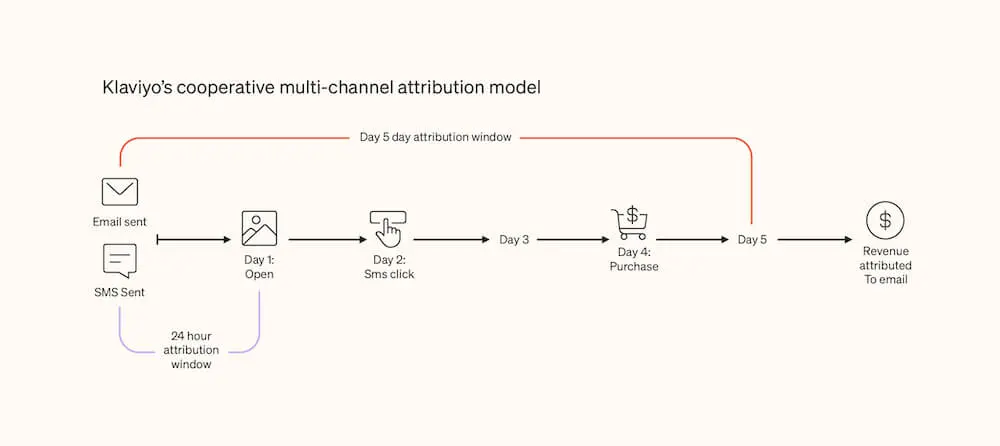
While all attribution windows in Klaviyo are configurable, we set default times to make it easy for you to focus on creating incredible customer experiences without worrying about setup.
- The default conversion period for email is 5 days: Many providers use 7-, 14-, or even 30-day email attribution windows. But consumer research suggests that emails “expire” in the mind of a consumer after 5 days, and so Klaviyo has conservatively made that our benchmark attribution window.
- The default conversion period for SMS is 24 hours: Other providers have attribution windows of 5 days or even 28 days for SMS. But marketing text messages tend to drive immediate action and, as a result, shouldn’t necessarily have long-lasting attribution windows.
We believe the customer journey is varied, rich, and complicated. Attribution should balance accuracy and conservatism.
At Klaviyo, we believe the customer journey is varied, rich, and complicated. Attribution should balance accuracy and conservatism.
If our attribution windows aren’t right for your brand, though, you can update them in your account settings.
Not a Klaviyo customer? Get a personalized demo here, or start a free trial below to learn more about what we offer.

Related content

Achieve more in 3 months with Klaviyo Marketing Analytics. This calendar gives you the structure and documentation you need to level up.

Discover 6 data-driven ways to use Klaviyo Marketing Analytics to boost BFCM performance, personalize campaigns, and drive long-term customer retention.

Use this quick customer lifetime value formula to understand your business health and customer experience.